IN MEMORIAM: GEORGE MÜLLER (1926-2025)
Georges (George) Ernest Müller, former Director of Spink’s Ancient Coin Department, passed away on 6th January, at the age of 98, surrounded by loved ones at his family home in La Rippe, Switzerland.
Born in Neuilly-sur-Seine, Paris on 6th December 1926, George was educated at the Lycée Pasteur, and later the École Supérieure de Commerce de Paris. He met his wife Annette, a close family friend, at the local church, and they were married in 1954. Together, they had four children, 17 grandchildren and one granddaughter.

George was the last of a truly excellent generation of numismatists, and although he officially retired to Switzerland in 1986, his impact and reputation in British numismatics was resounding, and he continued to be involved in the hobby and trade through to the end of his life. While many of George’s contemporaries are no longer with us, there are few active in today’s trade who have not heard of him, and many who will have handled material accompanied by tickets written in his hand. George was a grand master of ancient numismatics, well known and liked by his vast network of clients – collectors and dealers alike.

Following his studies, George decided to spend a few months in London to improve his English and perhaps gain some experience at a British banking firm, intending to return to France or his father’s native Switzerland to build a career there. Fortunately for Spink and the wider numismatic world, however, through a connection his father had to the management George was recommended to Spink. His interest in ancient history, as well as his linguistic skills, made him a prime candidate, and he entered the coin department as an assistant to the director, Leonard Forrer Senior.
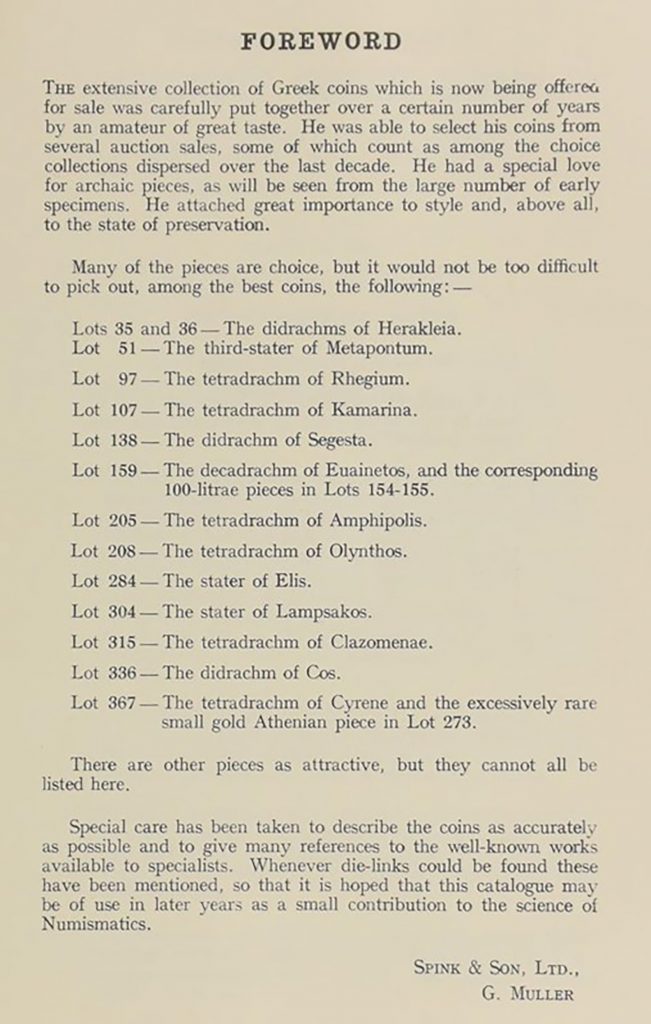
Forrer, by then nearing 80 years old, was a giant of the coin trade, with a tireless industry and meticulous attention to detail that was in itself, legendary. Forrer had been responsible for editing the Numismatic Circular, which at that time hosted articles in English, French and German, since 1892.
Suitably, Forrer was famously reluctant to specialise and instead learned as much as he could about every aspect of numismatics – ranging from completing and editing EA Sydenham’s The Roman Republican Coinage alongside Charles Hersh in 1953, to compiling the vast, eight-volume Biographical Dictionary of Medallists, coin-, gem-, and seal-engravers, mint-masters, etc, ancient and modern, with references to their works BC 500-AD 1900. Forrer’s encyclopaedic knowledge made his tutelage ideal for the young George Müller. As Spink’s predominant area of numismatic activity was, at this time, Greek and Roman coins, this was a natural avenue for George to ply his trade.
Spink’s directors warned George, bluntly, upon his arrival, that it would take him ten years to learn “enough to be useful”. George had never worked with ancient coins before but became enraptured with them, and doubtless influenced by Forrer’s wealth of knowledge and enthusiasm, learned everything he could. George’s progress was so meteoric that, within two years, far exceeding the forecasts of his superiors, he became Forrer’s righthand man. By the time Forrer died in 1953, George was put in charge of the Ancient Coin Department, rising to become Assistant Director and, later, Director.
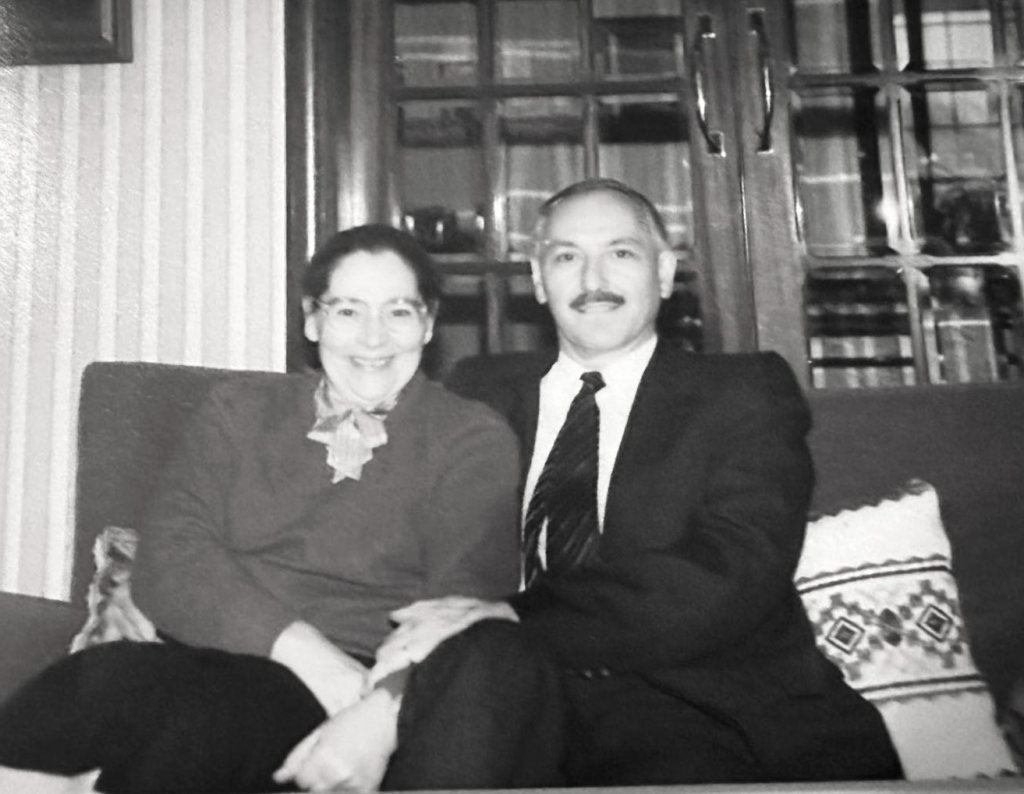
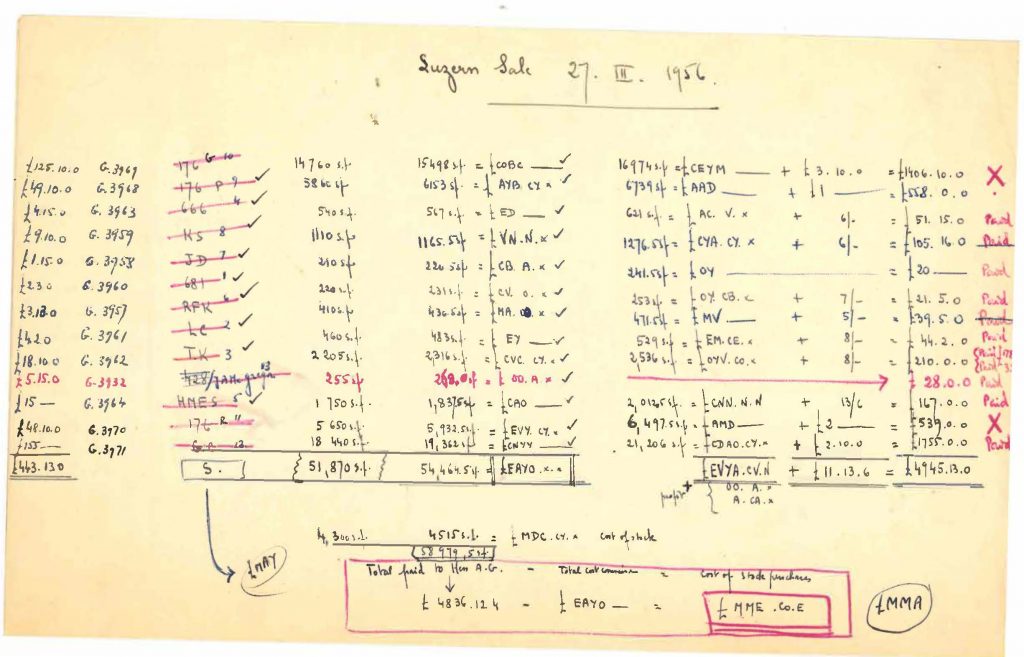
In those days, Spink was not an auction house, but a family-run business rooted in the trade of fine silver, English watercolours, oriental art and, of course, the dealing of coins and medals. Spink were, at that time, one of three major London dealers, along with AH Baldwin and BA Seaby, whose services were often employed in valuing and cataloguing the gigantic private collections to be sold by the leading auction houses such as Sotheby’s, Christie’s, and, exclusively by the time of George’s tenure, Glendining.
George’s first exposure to this was likely the Roman Republican collection of Rev EA Sydenham, which came to sale at Glendining in 1948, and the collection of Henry Platt Hall, which was likewise sold through the same in two parts across 1950. Leonard Forrer Sr was entrusted with amassing and describing these vast collections for sale, and authored the forewords for each, with Spink eventually purchasing the entirety of the second, Roman instalment of Hall en-bloc.
In the mighty ledger of Spink’s ancient coin department, one can see a multitude of entries in the stocklist, citing the “Sydenham” and ‘“HP Hall” provenances’ likely written up by a young George, some examples being sold on to major collectors or institutions.
Within a few short years, George was responsible for leading the cataloguing of some of these great collections, well-known to modern enthusiasts. Poignantly, one of the first sales he would have overseen as principal cataloguer would have been the late Leonard Forrer’s collection, which was sold through Glendining in April 1954. From there, George oversaw cataloguing for Glendining’s sales of some of the great collections of the era, well-known to many modern numismatists: 1955 “Collection of a Nobleman”, formed by the Count de Laval, notable for its quality Hellenistic material; their 1957 “Late Foreign Ambassador” (LFA) Collection, which contained some marvellous Roman gold; and the 1963 “Foreign Amateur” Collection of Greek, replete with wonderful examples from Magna Graecia, with George taking care to include die-links where identifiable, a rare inclusion for auction catalogues of the day, and as he modestly put it, ‘a small contribution to the science of numismatics’.
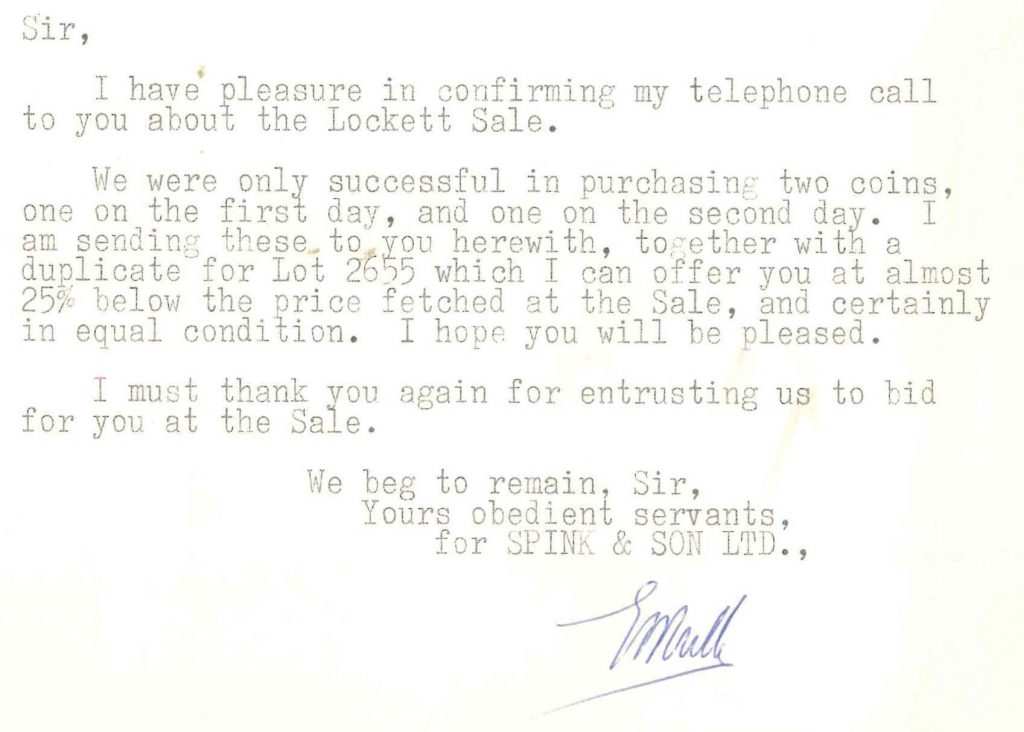
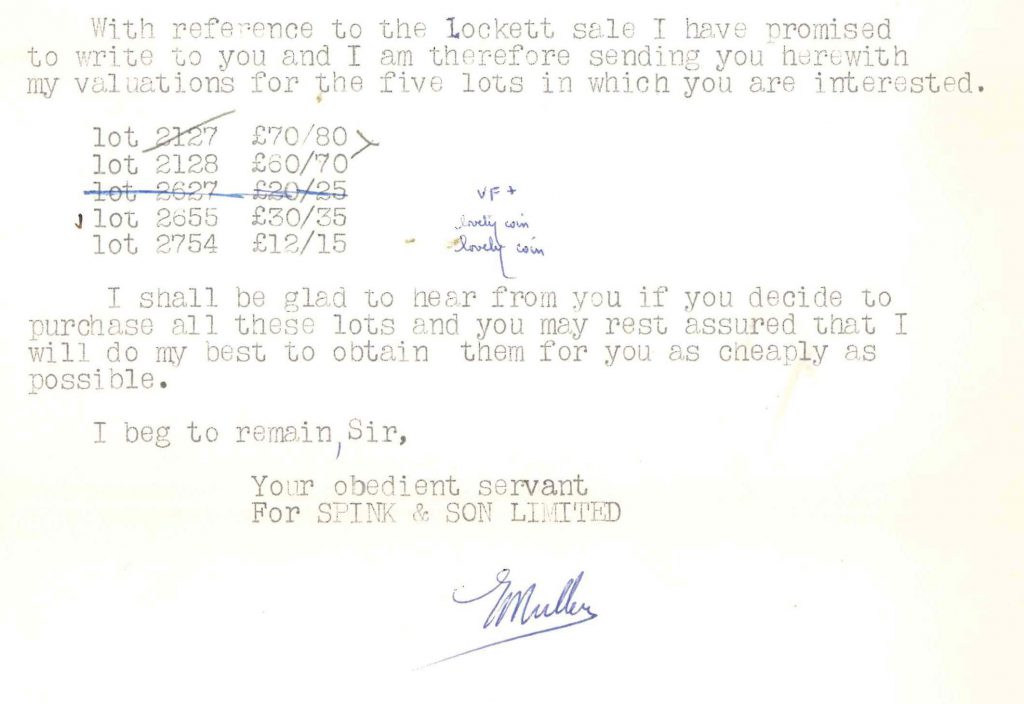
Outside of auction expertise, Spink’s main numismatic role was as a dealer. In addition to the monthly Numismatic Circular, the stewardship of which George took over from Forrer, Spink had a thriving over-the-counter retail trade, along with considerable business in buying on behalf of distinguished collectors.
In this, George was a considerable asset, following on from his predecessor, Forrer, who had represented clients at overseas auctions throughout the 1920s and 30s. George’s success in this field was due partially to his aptitude: he had developed an impeccable attention to detail in the coins he handled, and likewise, being of Swiss descent, he was multilingual and experienced in travel. But more than this, George excelled through his character: he was trustworthy, authoritative and open; people liked him and more importantly, trusted him to make a sensible decision in the interest of his clients.
With effortless charm and charisma, George developed relationships both in Britain and on the continent which allowed him to yield honest opinions from fellow dealers about the material he was inspecting. He would closely consider the requirements of his client and bid accordingly. In an industry which was then a rather secretive and exclusive, hierarchical system, with dealers and auctioneers acting as gatekeepers, this combination of expertise and human trust was crucial. This was true whether the customer was a budding young collector, or, as many Spink clients were, diplomats, nobles or monarchs. In a letter penned to one distinguished collector he represented at Part XII of the RC Lockett sale at Glendining in 1961, George reported that he had been outbid on a Tetradrachm of Seleucia Pieira, but that Spink had an example in stock which was at least as good at a fraction of the price. Having sold this example in a 2023 auction, we can confirm his assessment was absolutely correct. He knew the level of responsibility that was being placed with him by his clients and dutifully repaid their trust.
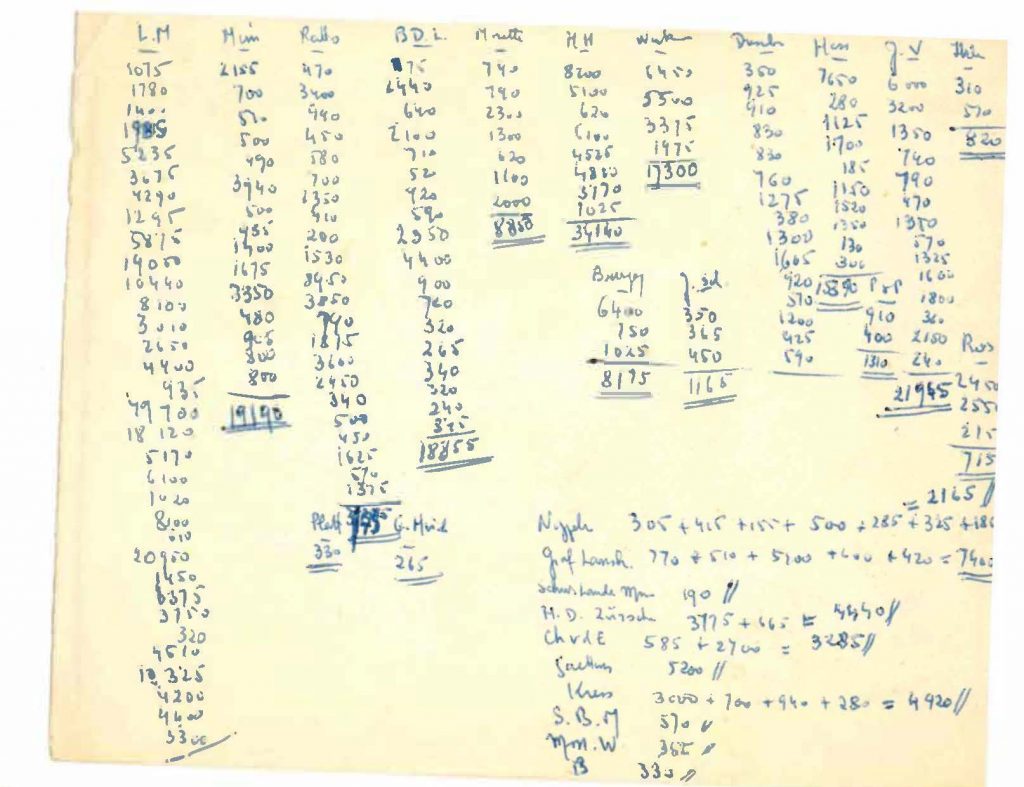
This impeccable reputation as a numismatist and a gentleman was borne out by the roster of important collectors George represented from the 1950s onwards. The Spink Library copies of catalogues from this time are full of George’s notes, keeping keen record of the buying patterns of competitors, notable new dealers and occasional points of critique for the cataloguing within. His calculations, laid out in his precise and thankfully clear handwriting, act as testament to herculean work he was carrying out on behalf of Spink and his clients. The names of many great collectors are noted in the marginalia, some of whom, such as Basil C Demetriadi (BCD), he is known to have represented. In the case of BCD, George bid on his behalf at part I of the Thomas O Mabbott Collection, sold through Schulman in June 1969, obtaining a large quantity of Roman Provincial coins that would make up the BCD Collection later on.
One notes from George’s correspondence a gentle pleasure in appraising material and acquiring it on behalf of others, keeping that balance between authority and deference which was crucial to the service he delivered. In correspondence with one collector in 1960, he remarked, regarding an Aureus of Faustina the Younger, “This empress was supposed to be a most charming woman, and the coin certainly does justice to this claim”; on an Aureus of Titus in 1967, he commented that “this is a most lovely specimen, really perfect in every way. It is very seldom one finds a piece of this quality, especially of Titus”. Elsewhere on invoices to commission bidders, he would often annotate ‘lovely coin’, or similar. Given that catalogue descriptions of the day were typically reserved and sober, it is clear that George greatly enjoyed his work, often staying at the office until 7 o’clock. It is no surprise that what George had intended to be a few months abroad to study English, became a stay of nearly four decades, with Annette working as a maths teacher at the Lycée Français in South Kensington, and the two of them raising their four children together in London.
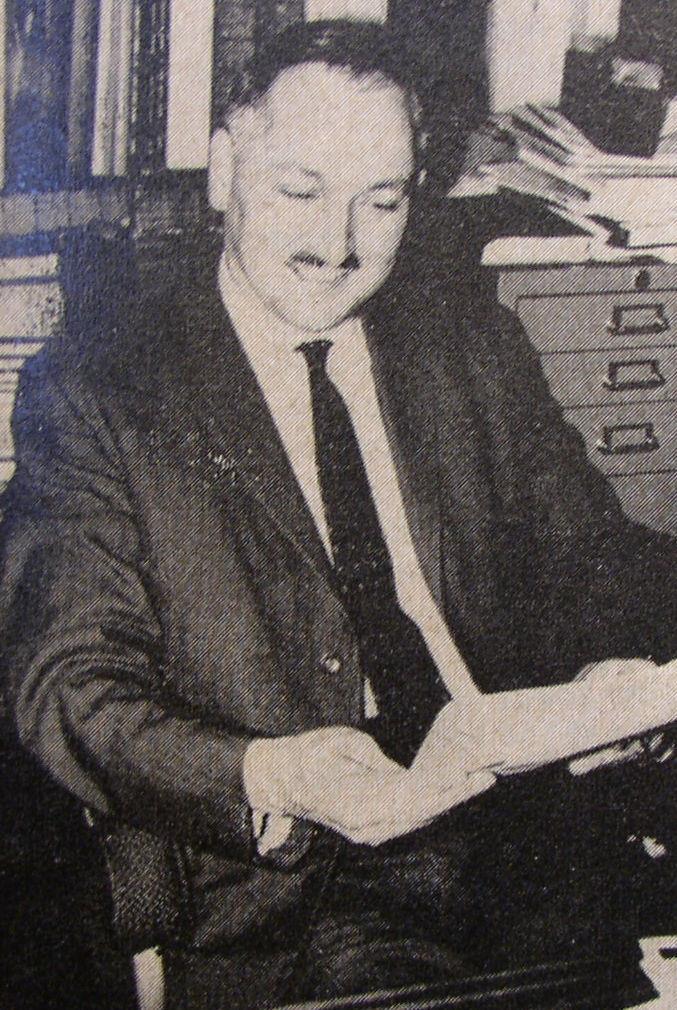
Coin News, 19 July 1973]
With the sale of Spink to Andrew Weir & Co in 1976, the company moved out of direct control of the Spink family. Unsurprisingly perhaps, the company underwent changes in its operation and, indeed, in its area of focus. George made the decision to depart Spink in 1982, and having married, built a career and raised a family in Britain, he left for Switzerland in 1986. Though officially retired, George remained a lifelong numismatist, enthusiastic and engaged in the coin business, still retaining many of the contacts he had made throughout his career. He helped develop and curate a brilliant corpus of Roman Republican coinage for an unknown collector, which was sold through Numismatica Ars Classica, as a “Collection of a Mentor and his Student” in 2013. In 2020, Leu Numismatik sold the “Kleinkunst” Collection, a selection of 300 coins from Classical Greece, the sum of many years of “fruitful exchange between the collector and his numismatic adviser”, George Müller. In addition to the countless collectors he advised and guided in their journey through numismatics, his legacy is further found among those numismatists he mentored at Spink: David Miller, John Pett and Barnaby Faull, to name a few.
Numismatics was very much a labour of love, and George would often reminisce with old colleagues and new friends about his storied career, while keeping up to date with the market. There is, however, more to life than coins and George enjoyed an equal measure of success and happiness in his family life. Happily married for 62 years, George and Annette built a family which ended up spanning across Switzerland, France, USA and Canada, but remained very close. His daughter Sylvie, whose first job was as a ‘Trilingual PA’ for her father when the family were in London, recalled George’s boundless love for his wife, family and friends; his delight in welcoming guests to La Rippe, and how he continued to live life to the absolute fullest right until the end. He was a keen and frequent traveller, making regular journeys to France and beyond to visit old friends and new arrivals in the family, who he would regale with stories of his life in numismatics, and carried on driving until he was 95. For his 98th birthday, he celebrated with a trip to Montreux and hosted 24 guests for his last Christmas in La Rippe. George loved his life and lived it well. He was devoutly religious, being heavily involved in church life in Britain and Switzerland. Reassured by his faith, he felt that at 98 he had “fulfilled his contract” and passed peacefully, surrounded by his loved ones.
He is survived by his children, Marie-Hélène, Philippe, Sylvie and Yvonne, his 17 grandchildren and a great-granddaughter.
Editorial Note: Spink are indebted in the writing of this tribute, firstly to the Müller family, and particularly the assistance of George’s daughter Sylvie, as well as family friend Philip Price, who informed us of his passing. Additionally, we would like to thank Mr Russo at NAC, whose introduction to the Mentor and
Student Collection has been quoted and utilised herein, along with Hadrien Rambach and Malcolm Hay for their assistance in research and recollections of George.
